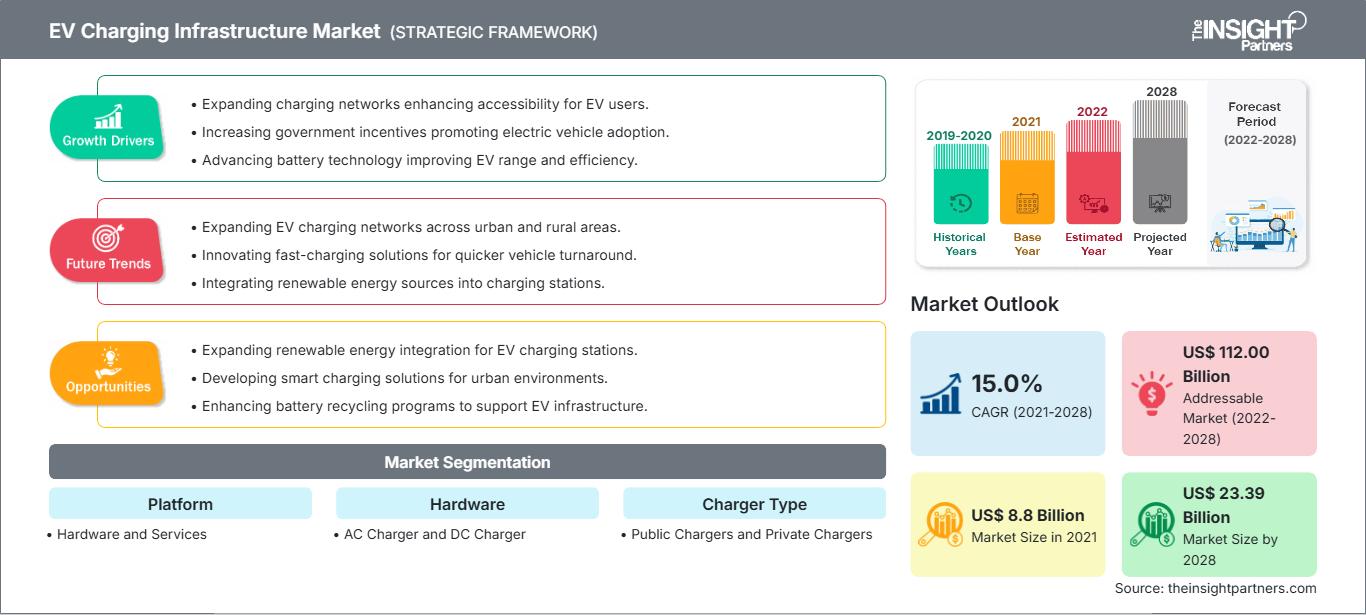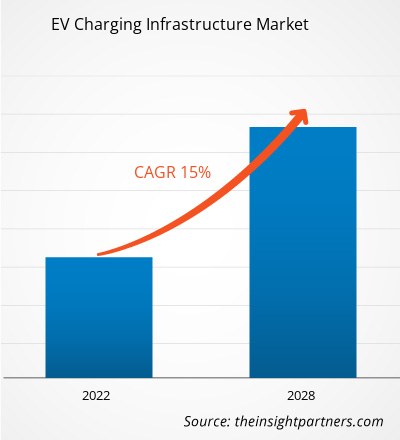[연구 보고서] EV 충전 인프라 시장은 2021년 88억 달러 규모였으며, 2028년에는 233억 9천만 달러에 이를 것으로 예상됩니다. 2021년부터 2028년까지 연평균 성장률(CAGR) 15.0%로 성장할 것으로 예상됩니다.
분석가 관점:
전기차(EV) 충전 인프라 시장은 지속 가능한 교통으로의 전 세계적인 전환에 힘입어 최근 몇 년간 상당한 성장과 발전을 이루었습니다. 점점 더 많은 국가와 정부가 온실가스 배출량 감축 및 기후 변화 대응을 위해 전기차 도입을 우선시함에 따라, 안정적이고 효율적인 충전 인프라에 대한 수요가 급증했습니다. EV 충전 인프라는 전기차 충전을 지원하는 충전소 네트워크와 관련 기술을 의미합니다. 이러한 충전소는 가정, 직장, 공공 충전소, 고속 충전소 등 다양한 형태로 제공되며, 다양한 충전 요구를 충족하고 EV 소유자에게 편의성을 제공하도록 설계되었습니다. 전기차 충전 인프라 시장의 핵심 동력 중 하나는 전기차 시장 자체의 성장입니다. 전기차 판매가 지속적으로 증가함에 따라, 도로 위를 달리는 전기차의 증가를 지원하기 위한 견고한 충전 인프라의 필요성이 더욱 중요해지고 있습니다. 또한, 전기차 도입을 장려하는 정부 정책, 보조금, 그리고 규제는 충전 인프라 개발에 중요한 역할을 해왔습니다. 여러 기업과 이해관계자들이 전기차 충전 인프라 시장에 적극적으로 참여하고 있습니다. 여기에는 기존 자동차 제조업체, 에너지 기업, 충전 네트워크 운영업체, 그리고 기술 제공업체가 포함됩니다. 이들은 혁신적인 충전 솔루션 개발, 충전 속도 향상, 그리고 사용자 경험 개선을 위해 협력하고 있습니다. 고속 충전 인프라는 장거리 주행과 주행 거리 불안 감소에 필수적이며, 전기차 소유자들이 장거리 주행 중에도 빠르게 충전할 수 있도록 지원합니다. 더욱이, 충전 인프라에 재생 에너지원을 통합하는 것이 점차 확산되고 있습니다. 재생 에너지로 구동되는 충전소는 충전과 관련된 탄소 배출을 줄이는 데 도움이 되어, 전반적인 전기 모빌리티 생태계를 더욱 지속 가능하고 환경 친화적으로 만듭니다.
시장 개요:
전기차 충전소는 플러그인 하이브리드 자동차와 전기 자동차를 전원에 연결하여 충전하는 데 사용되는 하드웨어입니다. 민간 기업이나 전기 공급 업체는 주차장, 쇼핑몰 등 공공 장소에 충전소를 설치합니다. 3핀 플러그, 공공 충전소, 가정용 벽면 충전기는 모두 전력망에서 전기 자동차를 충전하는 간단한 방법입니다. 차량-전력망 간(V2G) 기술은 향후 몇 년 안에 차량 소유주가 피크 시간대에 남는 전기를 전력망에 재판매할 수 있도록 지원할 것으로 예상됩니다.
요구 사항에 맞게 이 보고서를 사용자 정의하십시오.
이 보고서의 일부, 국가 수준 분석, Excel 데이터 팩을 포함하여 모든 보고서에 대한 사용자 정의를 무료로 받을 수 있을 뿐만 아니라 스타트업 및 대학을 위한 훌륭한 제안 및 할인을 이용할 수 있습니다
EV 충전 인프라 시장: 전략적 통찰력

- 이 보고서의 주요 주요 시장 동향을 확인하세요.이 무료 샘플에는 시장 동향부터 추정 및 예측에 이르기까지 데이터 분석이 포함됩니다.
이 보고서의 일부, 국가 수준 분석, Excel 데이터 팩을 포함하여 모든 보고서에 대한 사용자 정의를 무료로 받을 수 있을 뿐만 아니라 스타트업 및 대학을 위한 훌륭한 제안 및 할인을 이용할 수 있습니다
EV 충전 인프라 시장: 전략적 통찰력

- 이 보고서의 주요 주요 시장 동향을 확인하세요.이 무료 샘플에는 시장 동향부터 추정 및 예측에 이르기까지 데이터 분석이 포함됩니다.
시장 성장 동력:
전기차 시장 확대로 EV 충전 인프라 시장 성장 견인
전기차(EV) 시장의 발전은 EV 충전 인프라 시장 성장의 중요한 원동력입니다. 전기자동차에 대한 수요가 증가함에 따라 견고하고 광범위한 충전 인프라가 무엇보다 중요해지고 있습니다. EV 시장 확대를 이끄는 요인에는 여러 가지가 있습니다. 기후 변화와 대기 오염을 포함한 환경 문제에 대한 인식과 우려가 커지고 있습니다. 향상된 배터리 용량과 더 길어진 주행 거리를 포함한 EV 기술의 발전은 전기자동차의 매력과 실용성을 향상시켰습니다. 배터리 기술이 지속적으로 발전함에 따라 EV는 성능과 주행 거리 측면에서 경쟁력을 강화하고 있으며, 제한된 주행 거리와 충전 가용성에 대한 잠재 구매자의 우려를 해소하고 있습니다. 또한, 자동차 제조업체들은 전기자동차 모델 개발에 막대한 투자를 하고 있습니다. 자동차 산업의 주요 업체들은 다양한 차량 세그먼트에 걸쳐 점점 더 많은 EV 옵션을 출시하여 다양한 소비자의 선호도와 요구를 충족하고 있습니다. 전기차 시장이 확대됨에 따라 포괄적인 충전 인프라의 필요성이 더욱 중요해지고 있습니다. 전기차 소유자는 차량을 쉽고 효율적으로 충전할 수 있는 편리하고 안정적인 충전 솔루션을 필요로 합니다. 이러한 수요는 주택용 충전 옵션에만 국한되지 않습니다. 전기차 소유자는 일상적인 출퇴근과 장거리 이동을 위해 직장, 공공장소, 고속도로 등지에 있는 충전소를 이용할 수 있어야 하기 때문입니다. 충전 인프라 제공업체, 에너지 회사 및 기타 이해관계자들은 더 많은 전기차의 수요를 충족하기 위해 충전 네트워크에 투자하고 확장하는 것의 중요성을 인식하고 있습니다. 이들은 정부, 자동차 제조업체 및 기타 업계 관계자들과 협력하여 확장 가능하고 안정적이며 접근성이 높은 충전 솔루션을 개발하고 있습니다.
세분화 분석:
플랫폼을 기준으로 전기차 충전 인프라 시장은 하드웨어와 서비스로 구분됩니다. 하드웨어 부문은 2020년에 시장 점유율 1위를 차지했습니다. 여러 요인으로 인해 하드웨어 부문은 전기차 충전 인프라 시장의 최대 주주입니다. 다양한 지역에 충전소가 배치되어 있는 것이 이러한 시장 지배력에 기여하고 있습니다. 이 부문은 충전 인프라의 중추를 이루는 충전소의 제조, 설치 및 유지 관리를 포함합니다. 레벨 1, 2 및 DC 고속 충전기를 포함한 다양한 충전 솔루션이 하드웨어 부문의 시장 점유율을 견인하고 있습니다. 충전 하드웨어의 기술 발전과 물리적 인프라 투자의 연장된 수명은 하드웨어 부문의 입지를 더욱 공고히 합니다. 하드웨어 부문의 높은 시장 점유율은 자본 집약적 특성과 안정적이고 효율적인 충전 네트워크 구축에 있어 중추적인 역할을 반영합니다.
지역 분석:
아시아 태평양 EV 충전 인프라 시장은 2021년 미화 39억 9천만 달러 규모였으며, 2028년에는 미화 107억 7천만 달러에 이를 것으로 예상됩니다. 예측 기간 동안 연평균 성장률 15.2%로 성장할 것으로 예상됩니다. 아시아 태평양 지역은 성장과 시장 점유율에 기여하는 몇 가지 주요 요인을 통해 EV 충전 인프라 시장에서 우위를 점하고 있습니다. 이 지역은 전기차 도입이 크게 증가하여 전 세계적으로 가장 크고 빠르게 성장하는 전기차 시장이 되었습니다. 중국, 일본, 한국과 같은 국가들은 강력한 정부 지원, 인센티브, 그리고 야심찬 배출 감축 목표를 통해 전기차 도입을 촉진해 왔습니다. 이처럼 성장하는 전기차 시장은 전기차 충전 인프라에 대한 상당한 수요를 창출하여 아시아 태평양 지역의 시장 지배력을 강화했습니다. 아시아 태평양 지역은 특히 중국과 한국과 같은 국가를 중심으로 잘 발달된 제조 생태계의 이점을 누리고 있습니다. 이들 국가는 충전소, 케이블 및 관련 부품 제조에 상당한 투자를 해왔으며, 이를 통해 경쟁력 있는 가격으로 풍부한 충전 인프라를 공급할 수 있었습니다. 이를 통해 충전 솔루션 구축이 용이해지고 소비자의 접근성이 향상되었습니다. 또한, 아시아 태평양 지역은 포괄적인 충전 네트워크 구축에 적극적으로 나서고 있습니다. 정부와 업계 관계자들은 주거 지역, 상업 단지, 공공장소, 주요 교통로를 포함한 충전 인프라를 적극적으로 확장해 왔습니다. 이처럼 광범위한 네트워크는 전기차 소유자에게 편의성과 접근성을 제공하여 아시아 태평양 지역의 시장 지배력을 더욱 공고히 합니다. 기술 발전과 혁신 또한 아시아 태평양 지역의 시장 지배력 강화에 기여했습니다. 고출력 충전소와 스마트 충전 솔루션을 도입하고 무선 충전과 같은 신기술을 모색함으로써 EV 충전의 효율성과 사용자 경험이 향상되었습니다. 이러한 발전은 더 많은 소비자를 전기 자동차로 끌어들이고 충전 인프라에 대한 수요를 증가시켰습니다.
또한, 이 지역의 선도 기업과 시장 참여자들이 중요한 역할을 했습니다. BYD, NIO, 현대, LG전자를 포함한 아시아 제조업체들은 충전 인프라에 상당한 투자를 하고 시장 범위를 확대했습니다. 이들의 전문성, 기술 발전, 그리고 강력한 시장 입지는 아시아 태평양 지역 EV 충전 인프라 시장의 성장에 기여했습니다.
주요 업체 분석:
EV 충전 인프라 시장 분석은 Tritium, Blink Charging Co., ChargePoint, Inc., BP plc, EVBox, EVgo Inc., Tesla, Inc., Webasto Group, RWE AG 등의 업체로 구성됩니다. EV 충전 인프라 분야 주요 기업으로는 Tritium과 EVBox가 있으며, 다양한 제품 포트폴리오를 제공하는 것이 강점입니다.
EV 충전 인프라 시장 지역별 통찰력
The Insight Partners의 분석가들은 예측 기간 동안 EV 충전 인프라 시장에 영향을 미치는 지역별 동향과 요인을 면밀히 분석했습니다. 이 섹션에서는 북미, 유럽, 아시아 태평양, 중동 및 아프리카, 중남미 지역의 EV 충전 인프라 시장 부문 및 지역별 현황도 살펴봅니다.
EV 충전 인프라 시장 보고서 범위
| 보고서 속성 | 세부 |
|---|---|
| 시장 규모 2021 | US$ 8.8 Billion |
| 시장규모별 2028 | US$ 23.39 Billion |
| 글로벌 CAGR (2021 - 2028) | 15.0% |
| 이전 데이터 | 2019-2020 |
| 예측 기간 | 2022-2028 |
| 다루는 세그먼트 |
By 플랫폼
|
| 포함된 지역 및 국가 | 북미
|
| 시장 선도 기업 및 주요 회사 프로필 |
|
EV 충전 인프라 시장 참여자 밀도: 비즈니스 역학에 미치는 영향 이해
EV 충전 인프라 시장은 소비자 선호도 변화, 기술 발전, 그리고 제품 이점에 대한 인식 제고 등의 요인으로 인한 최종 사용자 수요 증가에 힘입어 빠르게 성장하고 있습니다. 수요가 증가함에 따라 기업들은 제품 및 서비스 확장, 소비자 니즈 충족을 위한 혁신, 그리고 새로운 트렌드를 적극 활용하며 시장 성장을 더욱 가속화하고 있습니다.

- 을 얻으세요 EV 충전 인프라 시장 주요 주요 플레이어 개요
최근 동향:
EV 충전 인프라 시장에서는 기업 인수합병과 같은 비기존 및 유기적 전략이 활발하게 활용되고 있습니다. 최근 주요 시장 동향은 다음과 같습니다.
- 2022년 11월, 율루(Yulu)는 카르나타카 주 정부와 양해각서(MoU)를 체결하고 향후 5년간 10만 대의 전기차(EV)를 도입하고 주 최대 규모의 EV 배터리 충전 및 교환 인프라를 가동하는 데 120억 루피(INR)를 투자할 계획이라고 발표했습니다.
- 2022년 10월, 룩셈부르크 정부는 전기차 충전 인프라 사업에 투자하는 기업에 재정 지원을 제공하는 첫 번째 사업 공모를 통해 29개 사업이 선정되었다고 발표했습니다. 참여 기업은 최소 175킬로와트 충전 용량의 충전소 구축과 관련된 투자에 대해 최대 50%의 보조금을 받게 됩니다.
- 과거 분석(2년), 기준 연도, CAGR을 포함한 예측(7년)
- PEST 및 SWOT 분석
- 시장 규모 가치/거래량 - 글로벌, 지역, 국가
- 산업 및 경쟁 환경
- Excel 데이터세트
최근 보고서
사용 후기
구매 이유
- 정보에 기반한 의사 결정
- 시장 역학 이해
- 경쟁 분석
- 고객 인사이트
- 시장 예측
- 위험 완화
- 전략 기획
- 투자 타당성 분석
- 신흥 시장 파악
- 마케팅 전략 강화
- 운영 효율성 향상
- 규제 동향에 발맞춰 대응






















 무료 샘플 받기 - EV 충전 인프라 시장
무료 샘플 받기 - EV 충전 인프라 시장